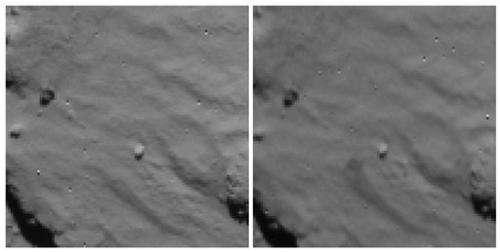This is a combination photo of two images released by the European Space Agency, ESA, Sunday Nov. 16, 2014. ESA says it provides strong indication that Philae touched down for the first time almost precisely where intended. The photo on the left was taken about 3 min 34 sec before touchdown, the photo on the right 1 min 26 sec after by the navigation camera (NAVCAM) on board Rosetta as the orbiter flew over the (intended) Philae landing site on Nov. 12. The touchdown is seen as a dark area in the lower center of the right image which is considered as strong indication that the lander touched down at this spot (possibly raising dust from the impact). They were taken from a distance of about 15 km from the surface, Since landing Wednesday on comet 67P/Churyumov-Gerasimenko some 311 million miles (500 million kilometers) away, the lander has performed a series of scientific tests. (AP Photo/ESA Rosetta/NAVCAM)
A first evaluation of the data that comet lander Philae sent to the European Space Center before its depleted batteries forced it to go silent will be released Monday, the German aeronautics and space research center said
The scientists are getting together to discuss their data analyses Monday morning and following that meeting, the center will publish the scientists' findings, spokesman Andreas Schuetz told The Associated Press.
Since landing Wednesday on comet 67P/Churyumov-Gerasimenko some 311 million miles (500 million kilometers) from Earth, the lander has performed a series of scientific tests and sent reams of data back to Earth.
In addition, the lander was lifted on Friday by about 4 centimeters (1.5 inches) and rotated about 35 degrees in an effort to pull it out of shadow so that solar panels could recharge the depleted batteries.
ESA's team of scientists have been evaluating the data to find out whether the experiments were successful—especially a complex operation Friday in which the lander was given commands to drill a 25-centimeter (10-inch) hole into the comet and pull out a sample for analysis.
Material beneath the surface of the comet has remained almost unchanged for 4.5 billion years, so the samples would be a cosmic time capsule that scientists are eager to study.
One of the things scientists are most excited about is the possibility that the mission might help confirm that comets brought the building blocks of life—organic matter and water—to Earth.
© 2014 The Associated Press. All rights reserved.
























